
Physetica is a genus of moths of the family Noctuidae. This genus is endemic to New Zealand.

Izatha prasophyta is a moth of the family Oecophoridae. It is endemic to New Zealand, where it is known from the North Island, except Hawkes Bay or the Wairarapa. Larvae likely feed on rotting wood although larvae of this species have been reared on the fruiting body of the bracket fungus Bjerkandera adusta. Adults are on the wing from November to February.
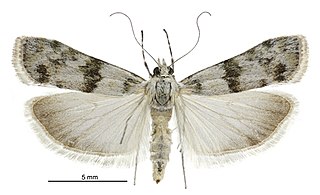
Eudonia asaleuta is a moth of the family Crambidae. It was described by Edward Meyrick in 1907. It is endemic to New Zealand and has been collected in the South Island in the West Coast, Fiordland,Canterbury, Otago and Southland regions. This species inhabits bare shingle areas as well as tussock habitat with few trees or scrub at altitudes of under 1000 m. Adults are on the wing from November to February.
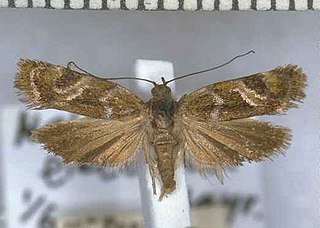
Hierodoris electrica is a moth of the family Oecophoridae. It was described by Edward Meyrick in 1889. It is endemic to New Zealand, where it has been reported from the northern and southern parts of the South Island. The larva of H. electrica has yet to be described. The wingspan is between 15 and 16.5 mm. The ground colour of the forewings is dark brown, with narrow yellow scales overlaying this base colour. The hindwings are brown. The known larval host species is Olearia nummulariifolia.

Eudonia asterisca is a moth in the family Crambidae. It was named by Edward Meyrick in 1884 and is endemic to New Zealand. It has been recorded in both the North and South Islands. This species is recorded as being present at sea level up to altitudes of 1350 m. This species has been recorded as inhabiting native podocarp/hardwood forests. The adults of this species are on the wing from December until March although they have also been recorded in October and November. They are attracted to light and have also been trapped via sugar traps.

Ichneutica ceraunias is a moth of the family Noctuidae. It is endemic to New Zealand. This species is found from the central North Island to the bottom of the South Island. Hosts of the larvae are species of Chionochloa and Festuca. This colourful moth is variable in appearance and can be mistaken for Ichneutica dione. Adults are on the wing from October to February.

Ichneutica cana is a moth of the family Noctuidae. It is endemic to New Zealand.
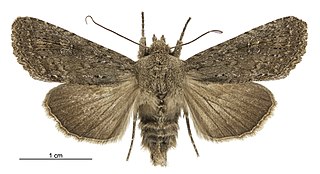
Physetica homoscia is a species of moth of the family Noctuidae. It is endemic to New Zealand and is found throughout New Zealand including in the Auckland Islands. This species inhabits places where its host plants are common and this includes costal dune habitat. It lives at a wide range of altitudes from sea-level up to at least 1750 m. The larvae of P. homoscia feed on Ozothamnus leptophyllus and Ozothamnus vauvilliersii. They are very active and drop to the ground when disturbed. Larvae are parasitised by a species of fly. This species pupates in the soil and the pupa life stage lasts for approximately 6 weeks. The adult moths are on the wing from September to June and are attracted to light. The adults of P. homoscia might possibly be confused with Ichneutica moderata however this latter species lacks the small white dots on the forewing veins of P. homoscia. Adults might also be confused with P. temperata but P. homoscia is significantly larger in size.
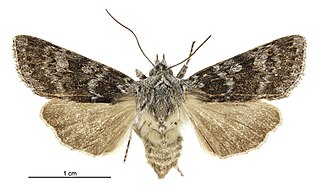
Physetica cucullina is a species of moth of the family Noctuidae. It is endemic to New Zealand and can be found throughout the South Island, apart from in the Nelson district with the exception of the St Arnaud Range where it is present. It is likely to be also resident in Stewart Island. P. cucullina lives in shrubland at subalpine and alpine zones but can occur at sea-level in the more southern regions. The life history of this species is poorly documented. There is only one known record in the New Zealand Arthropod Collection of the larvae of this species having been reared. These larvae were reared on Leucopogon fraseri. Adults of this species is on the wing from October to March and are attracted to light. P. cucullina is almost identical in appearance to P. funerea. The only reliable distinguishing feature between the two species is the antennae of the male. P. cucullina is also very similar in appearance to P. sequens but P. sequens lacks the narrow black line on the forewing dorsum area that can be present on the forewings of P. cucullina.
Physetica funerea is a species of moth of the family Noctuidae. It is endemic to New Zealand and is found only in the western and central parts of the South Island. This species inhabits shrubland in the subalpine and alpine zones. The life history of this species is unknown as are the larval host species. Adults of this species are on the wing from October to February. This species is almost identical to P. cucullina with the only difference between the two species being the structure of the male antennae. P. funerea is also similar in appearance to P. sequens, but the latter species tends to have a prominently underlined kidney-shaped mark nearer to the outer edge of the forewing.
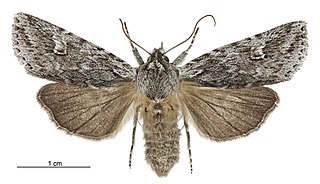
Physetica sequens is a species of moth of the family Noctuidae. It is endemic to New Zealand and can be found throughout the North and South Islands. It appears to be more common in the North Island than the South Island, and lives in open native shrublands, peatlands, Northland gumland, inland volcanic dunes, and Dracophyllum-dominated areas at altitudes that range from sea level to the alpine zone, up to at least 1600 m. Larvae of this species have been successfully reared on Leucopogon fasciculatus and Leptecophylla juniperina. The adults of this species are variable in appearance and are on the wing from September to March. P. sequens is similar in appearance to P. phricias but can be distinguished as P. phricias has a narrow black line along the dorsum of its forewing that P. sequens does not. P. sequens is also similar in appearance to P. cucullina however the forewing dorsum area of P. sequens does not have the narrow black line that is frequently present on P. cucullina forewings.

Tingena anaema is a species of moth in the family Oecophoridae. It is endemic to New Zealand and has been collected at Lake Wakatipu, Invercargill and Stewart Island / Rakiura. The adults of the species are on the wing in December.

Tingena aphrontis is a species of moth in the family Oecophoridae. It is endemic to New Zealand and has been collected at altitudes between 3000 - 5000 ft at Arthur's Pass and Mount Arthur. The species lives in open alpine habitat amongst alpine vegetation. Adults of the species are on the wing in January.

Tingena berenice is a species of moth in the family Oecophoridae. It is endemic to New Zealand and has been found in the North and South Islands. It is a brightly coloured species which is on the wing in November. Its preferred habitat is mixed beech forest.

Tingena chloritis is a species of moth in the family Oecophoridae. It is endemic to New Zealand and has been found in the South Island. Larvae of this species feed on leaf litter. The adults of this species are light flyers and are attracted to light.

Tingena falsiloqua is a species of moth in the family Oecophoridae. It is endemic to New Zealand and has been collected in the North Island. This species frequents subalpine native forest.

Tingena hemimochla is a species of moth in the family Oecophoridae. It is endemic to New Zealand and has been observed in the North Island. Adults of this species are on the wing from December until March.

Tingena oxyina is a species of moth in the family Oecophoridae. It is endemic to New Zealand and has been observed in the Otago region. This species inhabits native beech forest at altitudes of between 1000 - 3000 ft. Adults of this species are on the wing in January.

Trachypepla importuna is a moth of the family Oecophoridae first described by Edward Meyrick in 1914. It is endemic to New Zealand. Adults have been collected in the North Island in January but the species is regarded as being poorly known.
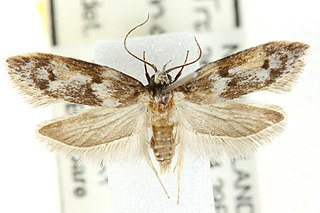
Trachypepla importuna is a moth of the family Oecophoridae first described by Edward Meyrick in 1927. This moth is regarded as having being introduced to New Zealand and is presumed to be native to Australia. T. importuna has been collected in both the North and South Islands of New Zealand. It inhabits native scrub and adults are on the wing in January and February. The placement of this species in the genus Trachypepla is regarded as being unsatisfactory and in need of revision.






















